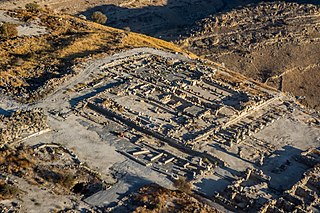 W
WThe Decapolis was a group of ten cities on the eastern frontier of the Roman Empire in the southeastern Levant in the first centuries BC and AD. They formed a group because of their language, culture, location, and political status, with each functioning as an autonomous city-state dependent on Rome. They are sometimes described as a league of cities, although some scholars believe that they were never formally organized as a political unit.
 W
WBeit She'an, also known as Beisan, and historically known as Scythopolis is a city in the Northern District of Israel, which has played an important role in history due to its geographical location at the junction of the Jordan River Valley and the Jezreel Valley. In the Biblical account of the battle of the Israelites against the Philistines on Mount Gilboa, the bodies of King Saul and three of his sons were hung on the walls of Beit She'an. In Roman times, Beit She'an was the leading city of the Decapolis, a league of pagan cities. In modern times, Beit She'an serves as a regional centre for the settlements in the Beit She'an Valley.
 W
WCapitolias was an ancient city east of the Jordan River, and is identified with the modern village of Beit Ras in the Irbid Governorate in northern Jordan. Anciently it was a town of Coele-Syria.
 W
WDium or Dion or Dia (Δία) was a city in ancient Coele-Syria mentioned by numerous ancient writers. According to Stephanus of Byzantium, the city was a foundation of Alexander the Great, and named after the city Dium in Macedon. It was also called Pella.
 W
WGadara, in some texts Gedaris, was an ancient Hellenistic city, for a long time member of the Decapolis city league, a former bishopric and present Latin Catholic titular see.
 W
WHippos is an archaeological site in Israel, located on a hill overlooking the Sea of Galilee. Between the 3rd century BCE and the 7th century CE, Hippos was the site of a Greco-Roman city, which declined under Muslim rule and was abandoned after an earthquake in 749. Besides the fortified city itself, Hippos controlled two port facilities on the lake and an area of the surrounding countryside. Hippos was part of the Decapolis, or Ten Cities, a region in Roman Jordan, Syria and Israel that were culturally tied more closely to Greece and Rome than to the Semitic ethnoi around.
 W
WJerash is a city in northern Jordan. The city is the administrative center of the Jerash Governorate, and has a population of 50,745 as of 2015. It is located 48 kilometres (30 mi) north of the capital city Amman.
 W
WPella is located in northwest Jordan at a rich water source within the eastern foothills of the Jordan Valley, close to the modern village of Ṭabaqat Faḥl some 27 km (17 mi) south of the Sea of Galilee. The site is situated 130 km (81 mi) north of Amman, a drive of about an hour and a half, and is a shorter half an hour by car from Irbid, in the north of the country. Today the city's ruins, predominately temples, churches and housing, have been partially excavated by teams of archaeologists, and attract thousands of tourists annually but especially in spring, during which time the area is awash with spring flowers.
 W
WThe Pompeian Era was a calendar era used by Hellenistic cities in Roman Palestine, in particular the cities of the Decapolis. The calendar counted the years from the region's conquest by the Roman general Pompey in 63 BC. Many of these cities had been self-governing poleis before the Jewish Hasmoneans had conquered them in the 2nd century BC. The Romans restored their self-governing status, so the conquest amounted to a "new foundation" of the cities, and they made that date the epochal year of their calendars. Some other nearby cities, such as Philadelphia, adopted the era even though they had never been under Hasmonean rule.
 W
WQanawat is a village in Syria, located 7 km north-east of al-Suwayda. It stands at an elevation of about 1,200 m, near a river and surrounded by woods. Its inhabitants are entirely from the Druze community. According to the Syria Central Bureau of Statistics (CBS), Qanawat had a population of 8,324 in the 2004 census.
 W
WRaphana, in present-day north of Jordan, was a city of the Decapolis. It is thought to lie north of Umm Qais in the Abilene plain. It is usually identified with Abila, a site in northern Jordan; i.e., Raphana is Roman phase of Abila.
 W
WUmm Qais or Qays is a town in northern Jordan principally known for its proximity to the ruins of the ancient Gadara. It is the largest city in the Bani Kinanah Department and Irbid Governorate in the extreme northwest of the country, near Jordan's borders with Israel and Syria. Today, the site is divided into three main areas: the archaeological site (Gadara), the traditional village, and the modern town of Umm Qais.